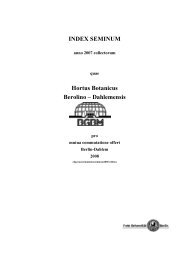Keys to the macrolichens and checklist of the lichens and ...
Keys to the macrolichens and checklist of the lichens and ...
Keys to the macrolichens and checklist of the lichens and ...
Create successful ePaper yourself
Turn your PDF publications into a flip-book with our unique Google optimized e-Paper software.
43a. Rhizines branched dicho<strong>to</strong>mous or squarrose (simple rhizines may also be present)<br />
............................................................................................................. Hypotrachyna<br />
43b. Rhizines simple (or at most forked)....................................................................... 44<br />
44a. Thallus closely appressed <strong>to</strong> substratum................................................................ 45<br />
44b. Thallus not appressed <strong>to</strong> substratum, with loosely overlapping lobes................... 47<br />
45a. Cilia present .................................................................................Hypotrachyna Key<br />
45b. Cilia absent............................................................................................................. 46<br />
46a. Thallus closely appressed on rock ................................................... Xanthoparmelia<br />
46b. Thallus closely appressed on rock ..........................................................Relicinopsis<br />
47a. Thallus grey-green (usnic acid absent) .................................................................. 48<br />
47b. Thallus yellow-green (usnic acid present) ............................................................. 50<br />
48a. Cilia present ........................................................................................................... 49<br />
48b. Cilia absent.......................................................................................... Canoparmelia<br />
49a. Rhizines branched dicho<strong>to</strong>mous or squarrose (simple rhizines may also be present)<br />
......................................................................................................Hypotrachyna Key<br />
49b. Rhizines simple (or at most forked), <strong>of</strong>ten absent along <strong>the</strong> lower margin ...............<br />
........................................................................................................ Parmotrema Key<br />
50a. Thallus with discrete or pustular soralia ............................. Flavoparmelia haysomii<br />
50b. Thallus without soralia; isidia sometimes present ........................... Xanthoparmelia<br />
Anzia Key (after Yoshimura, I., H.J.M. Sipman & A. Aptroot 1995. The lichen genus Anzia<br />
in New Guinea. Biblio<strong>the</strong>ca Lichenologica 58: 439-469.):<br />
1a. Without lobules, isidia, pustules or soredia; apo<strong>the</strong>cia <strong>of</strong>ten present...................... 2<br />
1b. With lobules, isidia, pustules or soredia; apo<strong>the</strong>cia usually absent ......................... 5<br />
2a. Spongiostratum moniliform, in interrupted, rounded patches ....A. pseudoangustata<br />
2b. Spongiostratum not moniliform, in a continuous b<strong>and</strong>............................................ 3<br />
3a. Upper surface <strong>of</strong> lobes ± convex; white marginal rim mostly absent; central cavity<br />
between spongiostratum <strong>and</strong> medulla present; medulla C+ red or rarely C-, with<br />
or without anziaic acid.........................................................................A. gregoriana<br />
3b. Upper surface <strong>of</strong> lobes ± flat; white marginal rim present; spongiostratum without<br />
cavities; medulla C+ red or (usually) C-, with or without anziaic acid ................... 4<br />
4a. Medulla C-, with lobaric acid or norlobaridone, without anziaic acid, never with<br />
yellow pigment........................................................................................A. semiteres<br />
4b. Medulla C+ red, with anziaic acid, sometimes with yellow pigment.A. end<strong>of</strong>lavida<br />
4c. Medulla C+red, with anziaic acid <strong>and</strong> 4-O-methylhypopro<strong>to</strong>cetraric acid.<br />
............................................................................................................ A. niuginiensis<br />
5a. With lobules or cylindrical isidia............................................................................. 6<br />
5b. With soralia or pustules ......................................................................................... 10




